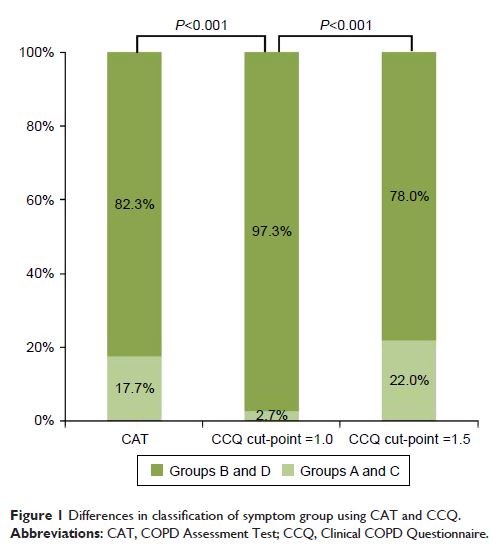108985
论文已发表
注册即可获取德孚的最新动态
IF 收录期刊
- 3.4 Breast Cancer (Dove Med Press)
- 3.2 Clin Epidemiol
- 2.6 Cancer Manag Res
- 2.9 Infect Drug Resist
- 3.7 Clin Interv Aging
- 5.1 Drug Des Dev Ther
- 3.1 Int J Chronic Obstr
- 6.6 Int J Nanomed
- 2.6 Int J Women's Health
- 2.9 Neuropsych Dis Treat
- 2.8 OncoTargets Ther
- 2.0 Patient Prefer Adher
- 2.2 Ther Clin Risk Manag
- 2.5 J Pain Res
- 3.0 Diabet Metab Synd Ob
- 3.2 Psychol Res Behav Ma
- 3.4 Nat Sci Sleep
- 1.8 Pharmgenomics Pers Med
- 2.0 Risk Manag Healthc Policy
- 4.1 J Inflamm Res
- 2.0 Int J Gen Med
- 3.4 J Hepatocell Carcinoma
- 3.0 J Asthma Allergy
- 2.2 Clin Cosmet Investig Dermatol
- 2.4 J Multidiscip Healthc

中国 COPD 临床人群 CCQ 和 CAT 健康状况评估的比较:一个横断面分析
Authors Zhou Z, Zhou A, Zhao Y, Duan J, Chen P
Received 1 January 2018
Accepted for publication 15 March 2018
Published 24 May 2018 Volume 2018:13 Pages 1675—1682
DOI https://doi.org/10.2147/COPD.S161225
Checked for plagiarism Yes
Review by Single-blind
Peer reviewers approved by Dr Charles Downs
Peer reviewer comments 2
Editor who approved publication: Dr Chunxue Bai
Background: Both the COPD Assessment Test (CAT) and the Clinical COPD Questionnaire
(CCQ) were recommended as comprehensive symptom measures by the Global
Initiative for Chronic Obstructive Lung disease. The main objective of this
work was to compare the evaluation of symptom severity with the CAT and the
CCQ and find a cutoff value of the CCQ for the Chinese clinical population.
Methods: Patients diagnosed with stable COPD in the outpatient department who
completed the CAT and CCQ were enrolled from November 2015 to December 2016.
Scores of 0–10, 11–20, 21–30, and 31–40 represent low, medium, high, and very
high impact level, respectively, by CAT. Scores of the CCQ can be considered as
acceptable (CCQ<1), acceptable for moderate disease (1≤CCQ<2),
instable-severe limited (2≤CCQ<3), and very instable-very severe limited
(CCQ≥3).
Results: According to the CAT, only 20.4% of patients belonged to the high
(21≤CAT≤30) and very high (31≤CAT≤40) impact levels, which were statistically
lower than those of the CCQ, which classified over half of the population
(51.1%) into the instable-severe limited (2≤CCQ<3) and very instable-very
severe limited (CCQ≥3) categories (P <0.001). The
kappa of agreement for the symptom groups by CAT and CCQ (cutoff point 1.5) was
0.495, but only slight agreement (0.144) was found between the CAT and CCQ with
the cutoff point of 1.0. The CAT and the total CCQ had a strong correlation
(rho=0.776, P <0.01). The CCQ 1.0 and 1.5
corresponded to CAT 4.2 and 9.7, respectively. The CAT 10.0 was equivalent to
1.53 of the CCQ. In addition, with higher scores of the CAT and CCQ, subjects
displayed more impairment in lung function, higher levels on modified Medical
Research Council, and higher exacerbation rates in the last year (P <0.001). Similarly, patients
with more exacerbations presented worse scores on the CAT and total CCQ as well
as its 3 domains (P <0.001).
Conclusion: Compared with the CAT, the CCQ was more likely to classify the
patients into more severe categories, and 1.5 might be a better cutoff point
for the CCQ than 1.0. Both the CAT and the overall CCQ with its 3 domains were
able to discriminate between groups of patients that differ in COPD severity.
Keywords: chronic obstructive pulmonary disease, COPD, the Clinical COPD Questionnaire,
CCQ, the COPD Assessment Test, CAT
